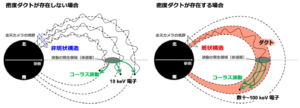Imaging paleoslabs and inferring the Clapeyron slope in D″ beneath the northern Pacific based on high-resolution inversion of seismic waveforms for 3-D transversely isotropic structure
Press Release
Kenji Kawai, Robert J.Geller, Yuki Suzuki
Highlights
- We use waveform inversion to infer 3-D local VS and anisotropy structure in D″.
- We image Izanagi, Farallon, and Telkhina slabs in D″ beneath the northern Pacific.
- Hot upwelling plumes are forming at the edges of the descending cold slab.
- Inferred Clapeyron slope is 10.2 ± 1.3 MPa/K in D″ beneath the northern Pacific.
Abstract
We use waveform inversion to infer high-resolution 3-D models of the S-velocity perturbation δVS and the anisotropy parameter δξ in the lowermost 400 km of the mantle beneath the northern Pacific. Our inferred models show three prominent features: (i) a widespread positive δVS layer with ~100 km thickness that exists ~250 km above the core-mantle boundary (CMB), which could be due to a bridgmanite to post-perovskite phase transition related to the D″ discontinuity; (ii) distinct positive –δVS anomalies with positive δξ resolved from 100 km to more than 400 km above the CMB, which could be the subducted Izanagi, Farallon, and Telkhinia slabs; (iii) a vertically continuous low-δVS anomaly with negative δξ at the edge of the subducted slab, which we interpret as an upwelling plume induced by slab sinking. We infer the Clapeyron slope of the post-perovskite phase transition in the lowermost mantle beneath the northern Pacific to be 10.2 ± 1.3 MPa/K, based on the δVS gradient as a function of depth for the inferred 3-D VS structure. Our estimated large positive Clapeyron slope at the CMB suggests vigorous convection in the lowermost mantle.
Graphical abstract















